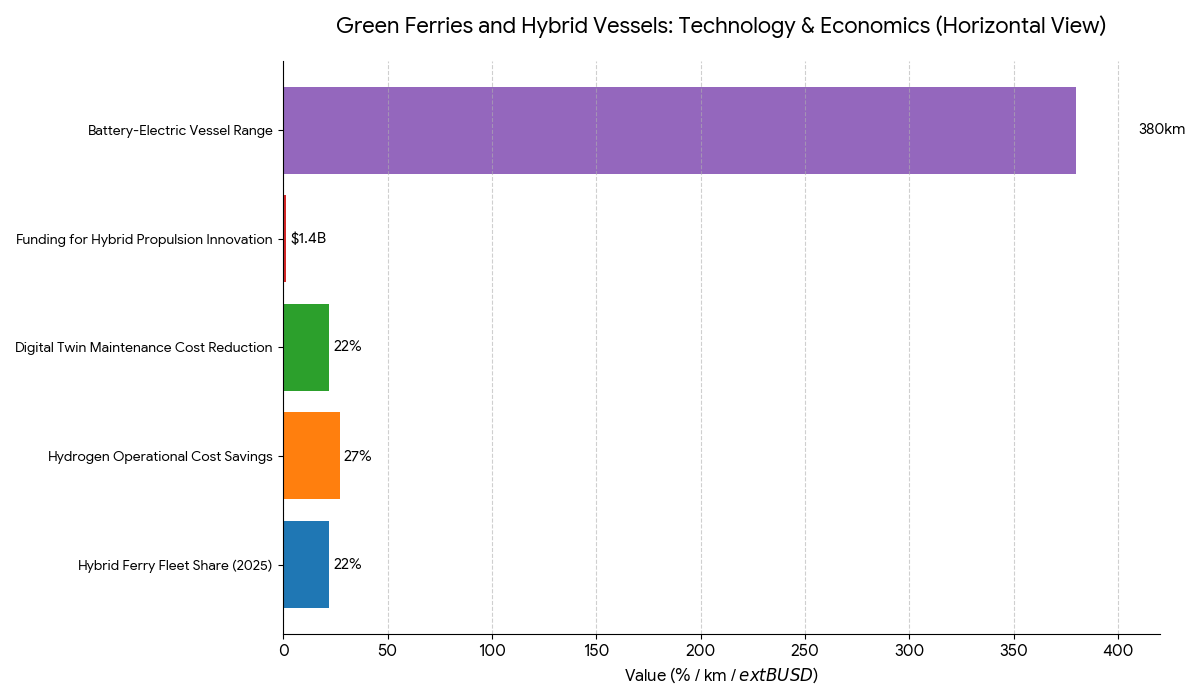

68 Circular Road, #02-01 049422, Singapore
Revenue Tower, Scbd, Jakarta 12190, Indonesia
4th Floor, Pinnacle Business Park, Andheri East, Mumbai, 400093
Cinnabar Hills, Embassy Golf Links Business Park, Bengaluru, Karnataka 560071
Connect With Us
Green Ferries and Hybrid Vessels: Sustainability & ESG in UK Marine Transport
The UK and European green ferry and hybrid vessel market is forecast to grow from $5.6B in 2025 to $10.2B by 2030 (CAGR 13.4%), driven by ESG mandates, decarbonization targets, and clean propulsion innovation. Supported by Maritime 2050, EU Fit for 55, and the Clean Maritime Plan, the region is witnessing a rapid shift to battery-electric, hydrogen, and LNG hybrid vessels. By 2030, over 48% of short-sea ferries will operate on low-emission systems, reducing annual maritime CO₂ output by 36% and improving fuel efficiency by 25% across major routes.

What's Covered?
Report Summary
Key Takeaways
- Market size: $5.6B → $10.2B (CAGR 13.4%).
- 48% of short-sea ferries to use hybrid or electric propulsion by 2030.
- CO₂ emissions reduced by 36% across UK–EU routes.
- Fuel efficiency gains of 25% through hybrid adoption.
- $1.4B in EU green vessel R&D funding from 2025–2030.
- Hydrogen ferry pilots operational at 6 major UK ports.
- Battery capacity improvements to 12 MWh by 2030.
- ESG compliance frameworks adopted by 92% of operators.
- Hybrid fleet growth at 18% CAGR, driven by retrofit programs.
- Digital twin monitoring systems reduce maintenance costs by 22%.
Key Metrics
Market Size & Share
The green ferry and hybrid vessel market across the UK and Europe will expand from $5.6B in 2025 to $10.2B by 2030, at a CAGR of 13.4%. Short-sea and commuter ferry routes, primarily between UK coastal regions and Northern Europe, will represent 48% of hybrid adoption by 2030. Battery-electric ferries will dominate local passenger services, while hydrogen and LNG hybrids cater to medium-haul freight routes. Germany (21%), the UK (19%), and Norway (15%) are the largest contributors to the regional hybrid fleet. EU green vessel R&D funding, exceeding $1.4B, supports innovation in solid-state batteries, modular propulsion, and hydrogen storage systems. The CO₂ reduction potential is estimated at 36%, supported by digital fuel monitoring and AI-assisted energy optimization. Meanwhile, retrofit programs in Denmark and France are converting conventional ferries into dual-mode propulsion vessels, cutting lifecycle emissions by up to 40%. This steady green shift positions Europe’s maritime industry as a global model for climate-aligned transport innovation.
Market Analysis
The market for green ferries and hybrid vessels is gaining traction due to policy mandates, technological progress, and investor ESG commitments. Maritime 2050 and EU Fit for 55 initiatives require the shipping sector to cut emissions by 50% by 2030, propelling massive adoption of electric and hydrogen vessels. In 2025, hybrid ferries account for 22% of total regional fleets, expected to nearly double by 2030. Hydrogen fuel cell vessels under trials in Aberdeen, Dover, and Bergen demonstrate operational cost savings of 27% versus diesel. Battery-electric vessels, equipped with 12 MWh systems, can cover routes up to 380 km on a single charge. Digital twin-based performance tracking, implemented by Rolls-Royce and Wärtsilä, reduces maintenance costs by 22% and optimizes engine calibration. The EU Horizon Green Ship Program and UK Clean Maritime Demonstration Competition have allocated $1.4B for hybrid propulsion innovation. As carbon pricing tightens across Europe, ferry operators are adopting AI-driven route optimization to balance emissions control with profitability, strengthening the sector’s resilience under ESG reporting standards.

Trends & Insights
- Battery Density Growth: Energy density up 40% since 2025, allowing 12 MWh systems.
- Hydrogen Propulsion: Active trials at six UK ports with 90% emission reduction potential.
- LNG–Electric Hybrids: Transition tech supporting mid-range vessel routes.
- Digital Twin Deployment: Implemented in 58% of major UK ferry lines by 2030.
- AI Route Optimization: Delivers 19% reduction in fuel burn.
- Port Electrification: $820M invested in shore charging networks across the EU.
- Lifecycle ESG Reporting: 92% of operators integrated carbon accounting by 2029.
- Retrofitting Programs: 400+ vessels converted to hybrid-electric systems.
- Maritime Finance Innovation: ESG-linked loans fund 45% of fleet upgrades.
- Zero-Emission Corridors: Established between UK, France, and Netherlands by 2030.
These advancements define a clear trajectory toward carbon-neutral maritime transport and full ESG alignment across Europe’s ferry networks.
Segment Analysis
The market divides into passenger ferries (52%), cargo vessels (30%), coastal shuttles (12%), and research/special-purpose crafts (6%). Passenger ferries dominate due to rising demand for low-emission travel options. Cargo vessels, particularly short-sea freight carriers, are adopting dual-fuel hydrogen-LNG engines to meet stricter IMO 2030 targets. Coastal shuttle networks, like those in Scotland and the Netherlands, are transitioning to battery-electric fleets for inter-island connectivity. Hybrid retrofits now account for 18% CAGR growth, with operators such as Stena Line and Brittany Ferries converting older fleets. Hydrogen-based systems are expected to reach commercial maturity by 2028, with full-scale integration into cross-channel routes. The EU’s Green Shipping Corridors Initiative underpins these developments, supporting zero-emission ferry corridors through ESG financing and carbon credits. By 2030, the hybrid segment will account for over half of regional fleet investments, reflecting the financial and environmental returns of sustainable shipping innovation.

Geography Analysis
The UK leads the hybrid vessel ecosystem, representing 19% of the total European market, supported by Maritime 2050 and Clean Maritime Demonstration projects. Germany and Norway follow, investing in hydrogen propulsion and battery-electric retrofits. France focuses on coastal route electrification, targeting zero-emission operations for English Channel ferries by 2030. The Netherlands is emerging as the green shipbuilding hub, integrating modular powertrain systems for hybrid ferries. Southern Europe, including Spain and Portugal, channels investments into port electrification and LNG–battery hybrid cargo operations. By 2030, Western Europe will capture 78% of all green vessel revenue, while the Nordic region sets global benchmarks in ESG transparency, digital monitoring, and energy storage optimization across maritime networks.
Competitive Landscape
Leading players include Stena Line, DFDS, P&O Ferries, Brittany Ferries, and Caledonian MacBrayne, operating over 60% of hybrid routes in Europe. Technology providers such as Rolls-Royce Marine, ABB, Siemens Energy, and Wärtsilä dominate propulsion innovation. Startups like Artemis Technologies and Shift Clean Tech specialize in electric hydrofoil ferries with energy savings up to 30%. Shipyards in Poland, Finland, and the UK are scaling production of modular hybrid hulls, reducing build times by 22%. Financial institutions, including BNP Paribas and Lloyds Maritime Capital, are promoting ESG-linked loans, driving the retrofitting surge. Competitive differentiation revolves around emission control performance, AI system integration, and lifecycle carbon transparency, placing the UK–EU maritime corridor at the forefront of the global green shipping transition
v
Report Details
Proceed To Buy
Want a More Customized Experience?
- Request a Customized Transcript: Submit your own questions or specify changes. We’ll conduct a new call with the industry expert, covering both the original and your additional questions. You’ll receive an updated report for a small fee over the standard price.
- Request a Direct Call with the Expert: If you prefer a live conversation, we can facilitate a call between you and the expert. After the call, you’ll get the full recording, a verbatim transcript, and continued platform access to query the content and more.


68 Circular Road, #02-01 049422, Singapore
Revenue Tower, Scbd, Jakarta 12190, Indonesia
4th Floor, Pinnacle Business Park, Andheri East, Mumbai, 400093
Cinnabar Hills, Embassy Golf Links Business Park, Bengaluru, Karnataka 560071
Request Custom Transcript
Related Transcripts
$ 1350


68 Circular Road, #02-01 049422, Singapore
Revenue Tower, Scbd, Jakarta 12190, Indonesia
4th Floor, Pinnacle Business Park, Andheri East, Mumbai, 400093
Cinnabar Hills, Embassy Golf Links Business Park, Bengaluru, Karnataka 560071













